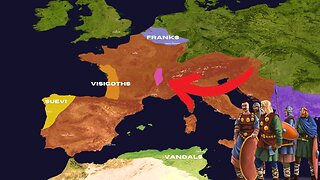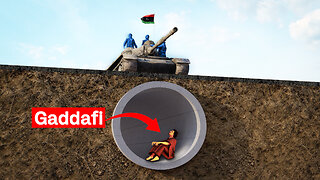Premium Only Content

The ancient Roman watermill complex that almost sparked an industrial revolution.
🔴 YOU WANT TO SUPPORT THIS CHANNEL? 🔴
🤗 Join our Patreon community: https://www.patreon.com/Maiorianus
🤗 One-Time Donation?
- PayPal: https://paypal.me/Maiorianus
- Bitcoin: bc1qv4lsfsplvfecrrgvmfclhga28we7mvh9563xdj
🔗 Share the video with anyone who might be interested (it helps a ton!)
👍 Subscribe to our videos FOR FREE!
📬 Contact us: maiorianus.sebastian@gmail.com
It is sometimes astounding to see how close the Romans came to some form of industrial revolution. Not only was the steam engine almost invented in Alexandria in the 1st century AD, but the Romans also built an industrial scale flour grinding complex at Barbegal, near the roman city of Arelate in southern Gaul. This incredible complex of 16 water wheels, arranged in two parallel sets of eight, was built such as to harness the full power of water, in order to use the kinetic energy for industrial applications. They were completed in the early 2nd century AD and operated for around 200 years, grinding massive amounts of grain every single day, and thus creating flour which would be baked into bread for the people of Arelate. It is estimated that 4.5 metric tons of flour were grinded there every single day. This was truly an industrial operation, which Europe would not see again in this form for 1500 years. But even though the spark of the industrial revolution did not manage to materialize in the Roman empire, it is said that the benedictine monks preserved and cultivated this ancient art of watermilling, inventing ever more elaborate uses of hydro energy, which would then in the 18th century britain contribute to the industrial revolution. So even though the Romans failed to industrialize, they were really quite close, and with a big delay, their knowledge contributed to our industrial revolution 1500 years later.
-
 13:29
13:29
Maiorianus
7 months agoThis Often Overlooked Germanic Tribe Played A Huge Part In The Fall Of Rome.
49 -
 13:09
13:09
Forrest Galante
10 hours agoWildlife Expert Reacts To Deadly Australian Animal TikToks
47K4 -
 12:08
12:08
Zoufry
2 days agoThe Mystery of Gaddafi's Final 24 Hours
8.67K11 -
 18:25
18:25
Liberty Hangout
13 days agoAnti-Ice Demonstrators Love Poop!
44.4K66 -
 9:39
9:39
MattMorseTV
16 hours ago $1.05 earnedVance just DROPPED a BOMBSHELL.
40.2K64 -
 23:47
23:47
GritsGG
1 day agoThe Forgotten Best Sniper Support AR!
15.5K3 -
 1:15:48
1:15:48
The Pascal Show
18 hours ago $0.10 earnedMUGSHOTS RELEASED! Emmanuel Haro's Parents Mugshot Released To The Public
12.2K1 -
 14:45
14:45
BlabberingCollector
21 hours agoKings Cross Station SET LEAKS! | Harry Potter HBO Show Update & News
11.8K1 -
 33:20
33:20
SB Mowing
9 days agoHealth Struggles + Endless Rain = A Yard Out of Control
20K19 -
 1:09:42
1:09:42
Mike Rowe
4 days agoHow Did THIS Dirty Job Make Tommy Mello A Billionaire?! | #447 | The Way I Heard It
79.6K20